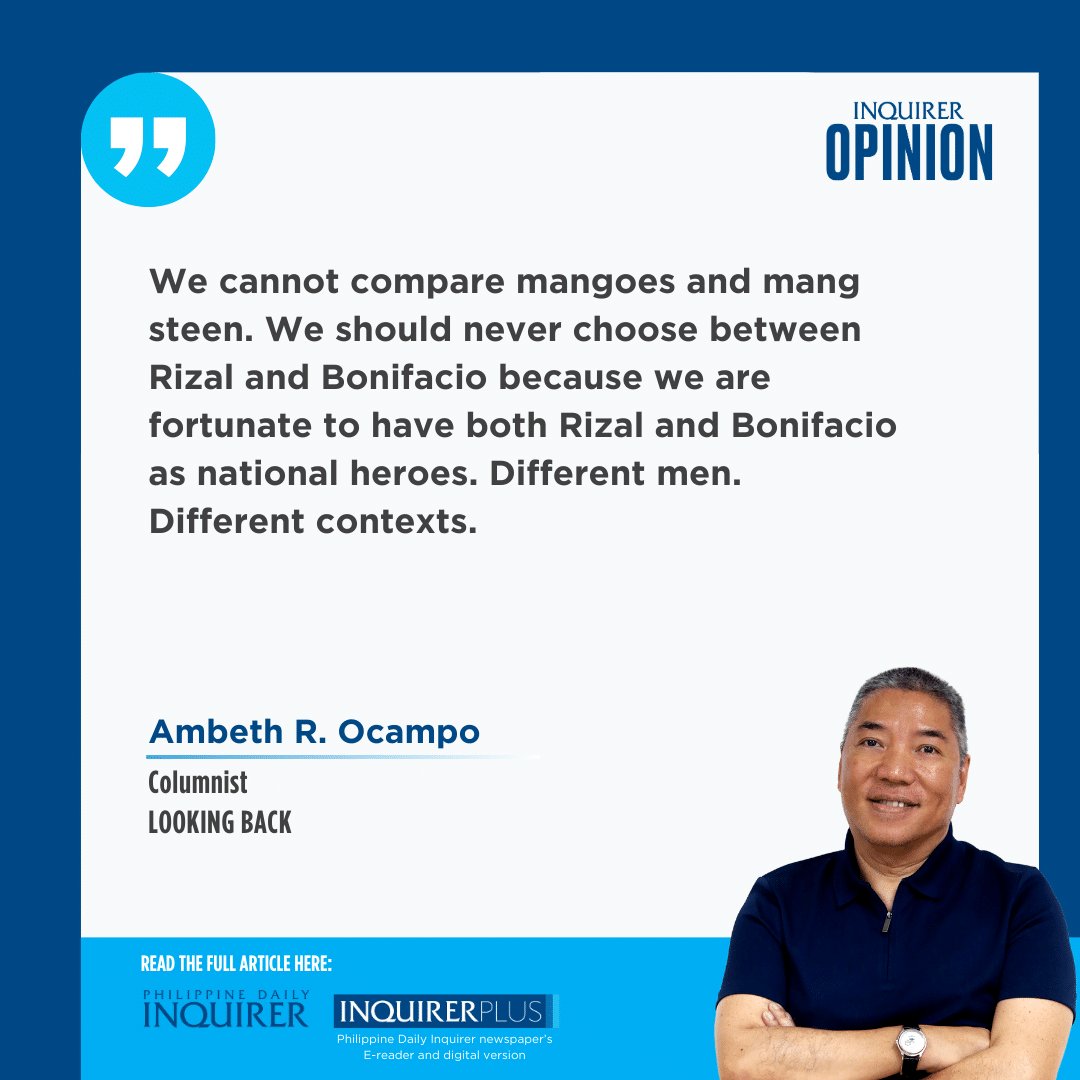Sentiment is one of the hurdles to our understanding of Philippine history. It is set early on when Araling Panlipunan makes students choose between Jose Rizal and Andres Bonifacio. Who is better? More worthy of being the national hero? Some learn that Emilio Aguinaldo “killed” Andres Bonifacio and Antonio Luna. On these issues, students are encouraged to use their feelings and gut feelings rather than look squarely at the facts to learn: nuance, context, understanding, and, most important of all, empathy.
We cannot compare mangoes and mangosteen. We should never choose between Rizal and Bonifacio because we are fortunate to have both Rizal and Bonifacio as national heroes. Different men. Different contexts. Between political rivals Emilio Aguinaldo and Bonifacio, they had different methods, but one aim: freedom for the Philippines and the Filipinos from colonial bondage. History teaches us that Bonifacio was tried for treason and sentenced to death by a military court.
Aguinaldo commuted capital punishment to banishment but, in the end, was advised by military leaders (some allied with Bonifacio) to proceed with the execution. Bonifacio’s death was not at Aguinaldo’s hands but in the hands of Filipino soldiers. And here lies the rub—unlike Rizal, who was executed by the enemy, Bonifacio was killed by the very revolution he started. He was killed by fellow Filipinos. An inconvenient fact in the complicated emergence of a nation. Those who believe that judgment is flawed today are using hindsight. History teaches context, helping us understand why things happened the way they did. History does not always unfold the way we want it to be.
Luna’s assassination is complicated. There is no biased military court here, but a heavy air of mistrust fueled by Luna’s temper, political intrigue from his enemies, and revenge from people he had wronged. Historian Teodoro Agoncillo related that, in a private conversation, Ferdinand E. Marcos Sr. proudly declared his relation to Luna. Agoncillo said under his breath, “Well, that’s your misfortune.” He then explained to me that Luna had Ilocano ancestry from his mother, but he was born in Urbiztondo Street, San Nicolas, a Manila suburb. If we are to go by his pen-name “Taga-ilog,” he was more Tagalog than Ilocano. When I asked, wasn’t he the greatest Filipino general of the Philippine-American war? Agoncillo roared, “Luna was the greatest Filipino general of the Philippine-American War who did not win a single battle!”
That afternoon with Agoncillo made me unlearn a lot from previous school history. I was made to go beyond the bare bones of history: dates, names, places, and chronology. I was taught to develop a critical and more nuanced view of the past. Revisiting Luna’s death on June 5, 1899, at the hands of Aguinaldo’s bodyguards in the church grounds of Cabanatuan was gut-wrenching. Physical examination revealed Luna had received over 31 (other accounts say 41) wounds from bullets and bolos, most of them mortal. Bullets singed the uniform he was wearing. An indication he was shot at close range. Emilio Aguinaldo was not present during the murder.
When you read the standard secondary works on the Luna assassination: Teodoro Agoncillo’s “Malolos: Crisis of the Republic” (1960) and Vivencio Jose’s “The Rise and Fall of Antonio Luna” (1972), the accusing finger of history points at a handful of people who had motive for murder: Pedro Janolino aka “Pedrong Kastila,” a soldier Luna cursed and punished for insubordination. Janolino, claiming self-defense, dealt the first blow with a bolo on Luna’s temple which was followed by furious shooting, stabbing, and hacking away by men under his command. Felipe Buencamino, member of the Malolos Congress and later secretary of foreign relations, had a verbal disagreement with Luna who branded Buencamino and his son traitors to the cause of Philippine freedom.
During a tense meeting, Luna was restrained from assaulting Buencamino who is quoted to have warned: “This aggression will cost you very dearly, General.” Buencamino watched the assassination from the convent window, afterward ordering all incriminating papers, including the telegraph summons to Cabanatuan, taken from Luna’s corpse.
Under the radar, in all accounts, including Jerrold Tarog’s hit movie “Heneral Luna” (2015), is Trinidad Famy, Aguinaldo’s mother, who watched the deed from the convent window. Gregorio Fajardo quoted her shouting at the murderers: “Bakit ninio pinatay ang general? Diba ninio nakikilala sya? Masasama kayong manga tauo!” (Why did you kill the general? Didn’t you recognize him? You are bad people!) Gen. Venancio Concepcion and others quote her asking, with an impatient tone, “Ano ba, nagalaw pa iyan?” (C’mon, is he still moving?) Juan Villamor points to Aguinaldo’s mother as one of the conspirators in “Tragica Muerte del General Luna” (Tragic Death of General Luna, 1932). Excessive maternal protection was given as the motive.
Contrary to viral clickbait last weekend that branded this as “breaking news,” it is 92-year-old news. Clout-chasers should not sensationalize, return to the primary sources, and heed Andres Bonifacio’s warning to “Fear history, for it respects no secrets.”
—————-
Comments are welcome at aocampo@ateneo.edu
